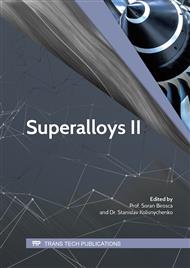[1]
R.C. Reed, The superalloys: fundamentals and applications, Cambridge university press2008.
Google Scholar
[2]
Z. Zhu, H. Basoalto, N. Warnken, R. Reed, A model for the creep deformation behaviour of nickel-based single crystal superalloys, Acta Mater 60(12) (2012) 4888-4900.
DOI: 10.1016/j.actamat.2012.05.023
Google Scholar
[3]
B. Dyson, Microstructure based creep constitutive model for precipitation strengthened alloys: theory and application, Mater Sci Technol-lond 25(2) (2009) 213-220.
DOI: 10.1179/174328408x369348
Google Scholar
[4]
F. Nabarro, C.M. Cress, P. Kotschy, The thermodynamic driving force for rafting in superalloys, Acta Mater 44(8) (1996) 3189-3198.
DOI: 10.1016/1359-6454(95)00423-8
Google Scholar
[5]
T. Ohashi, K. Hidaka, S. Imano, Elastic stress in single crystal Ni-base superalloys and the driving force for their microstructural evolution under high temperature creep conditions, Acta Mater 45(5) (1997) 1801-1810.
DOI: 10.1016/s1359-6454(96)00324-2
Google Scholar
[6]
B. Fedelich, A. Epishin, T. Link, H. Klingelhöffer, G. Künecke, P.D. Portella, Rafting during high temperature deformation in a single crystal superalloy: experiments and modeling, Superalloys 2012, TMS, 2012, pp.491-500.
DOI: 10.1002/9781118516430.ch54
Google Scholar
[7]
R. Rettig, N.C. Ritter, H.E. Helmer, S. Neumeier, R.F. Singer, Single-crystal nickel-based superalloys developed by numerical multi-criteria optimization techniques: design based on thermodynamic calculations and experimental validation, Model Simul Mater Sc 23(3) (2015) 035004.
DOI: 10.1088/0965-0393/23/3/035004
Google Scholar
[8]
R. Reed, T. Tao, N. Warnken, Alloys-by-design: application to nickel-based single crystal superalloys, Acta Mater 57(19) (2009) 5898-5913.
DOI: 10.1016/j.actamat.2009.08.018
Google Scholar
[9]
B. Fedelich, G. Künecke, A. Epishin, T. Link, P. Portella, Constitutive modelling of creep degradation due to rafting in single-crystalline Ni-base superalloys, Mater Sci Eng A 510-511 (2009) 273-277.
DOI: 10.1016/j.msea.2008.04.089
Google Scholar
[10]
Y.-N. Fan, H.-J. Shi, W.-H. Qiu, Constitutive modeling of creep behavior in single crystal superalloys: Effects of rafting at high temperatures, Mater Sci Eng A 644 (2015) 225-233.
DOI: 10.1016/j.msea.2015.07.058
Google Scholar
[11]
D. Dye, J. Coakley, V. Vorontsov, H. Stone, R. Rogge, Elastic moduli and load partitioning in a single-crystal nickel superalloy, Scripta Mater 61(2) (2009) 109-112.
DOI: 10.1016/j.scriptamat.2009.03.008
Google Scholar
[12]
A. Sato, H. Harada, A.-C. Yeh, K. Kawagishi, T. Kobayashi, Y. Koizumi, T. Yokokawa, J. Zhang, A 5th generation SC superalloy with balanced high temperature properties and processability, Superalloys (2008) 131-138.
DOI: 10.7449/2008/superalloys_2008_131_138
Google Scholar
[13]
Y. Koizumi, T. Kobayashi, T. Yokokawa, J. Zhang, M. Osawa, H. Harada, Y. Aoki, M. Arai, Development of next-generation Ni-base single crystal superalloys, Superalloys 2004 (2004) 35-43.
DOI: 10.7449/2004/superalloys_2004_35_43
Google Scholar
[14]
S. Tian, Y. Su, B. Qian, X. Yu, F. Liang, A. Li, Creep behavior of a single crystal nickel-based superalloy containing 4.2% Re, Mater Design 37 (2012) 236-242.
DOI: 10.1016/j.matdes.2012.01.008
Google Scholar
[15]
J. Gong, D. Snyder, T. Kozmel, C. Kern, J.E. Saal, I. Berglund, J. Sebastian, G. Olson, ICME Design of a Castable, Creep-Resistant, Single-Crystal Turbine Alloy, JOM (2017) 1-6.
DOI: 10.1007/s11837-017-2300-3
Google Scholar
[16]
J. Zhang, T. Murakumo, H. Harada, Y. Koizumi, Dependence of creep strength on the interfacial dislocations in a fourth generation SC superalloy TMS-138, Scripta Mater 48(3) (2003) 287-293.
DOI: 10.1016/s1359-6462(02)00379-2
Google Scholar
[17]
A.-C. Yeh, A. Sato, T. Kobayashi, H. Harada, On the creep and phase stability of advanced Ni-base single crystal superalloys, Mater Sci Eng A 490(1-2) (2008) 445-451.
DOI: 10.1016/j.msea.2008.02.008
Google Scholar
[18]
A. Epishin, T. Link, H. Klingelhöffer, B. Fedelich, U. Brückner, P.D. Portella, New technique for characterization of microstructural degradation under creep: Application to the nickel-base superalloy CMSX-4, Mater Sci Eng A 510 (2009) 262-265.
DOI: 10.1016/j.msea.2008.04.135
Google Scholar



